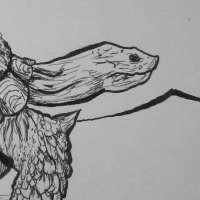
The beasts that plague the cliffs and skies of the Gryphon Runs are often viewed as a curse, killing livestock and people regularly, every year. Once a year, the peoples of the Runs come together to race the gryphons, pulling them away from the cliff city for a short reprieve. During this time, those who are not racing through the sands on blood-covered horses may sneak up the ridges to steal the ever-coveted gryphon eggs.
Once the riders who survive the race make it home, a great feast is held to celebrate their victory and the centerpiece of every feast are the gryphon eggs.
It was the third year of the Modain Races when those left in city realized that both the male and female gryphons chased the riders. Mated pairs would fly screeching after the racers, leaving nests full of eggs completely unattended. Any other time, the eggs were a rare and priceless treat, but during the Modain Races, the nests were free for the looting.
That first year, the people of the Gryphon Runs managed to collect so many eggs that in the years to follow the population of the gryphons was nearly halved. Fewer gryphons meant fewer deaths and the feast of eggs was enough to make it a permanent part of the racing tradition from then on.
Retrieving the eggs is no small matter. Gryphons roost in the jagged cliff sides, building their nests in small crevasses hundreds of feet above the sandy badlands below. They also tend to prefer using nettles and briar bush as the base of their nests, so even those who make it to the nest are at risk of flaying themselves on the sharp, dry thorns if they are not careful.
The soft, brittle nature of the stones make anchoring rope too dangerous, so climbers must be light and swift. Untethered climbers will edge along the cliff side with bare hands and feet, with net bags draped over the backs. Once they make it safely to a nest, they quickly scoop the eggs, large as a man's head, into the net then move to the next. Inevitably, some climbers fall to their deaths every year, but it is not nearly so dangerous as the races or egg hunting when the gryphons are near.
Once the cache of eggs is safely back in the city, the cooking begins. The large eggs are boiled in their shells in sweet juniper wine. When their silky whites are firm, the shells are cracked, then the eggs are cooled in vats of yucca flower juice. The shells are peeled away, revealing delicate blue marbled patterns. They are then displayed and served on beds of sage leaves and juniper berries.
The rest of the feast consists of roasted horse flanks, yucca fruit poached with cardamom and saffron, and juniper berry pastries. The dessert only offers so many natural resources but the Feast of the Races would be suited to the table of any king.
The winners of the races are always served the eggs first, then the egg hunters, and then the rest of the guests. Even when enough eggs have been gathered to feed every guest and then some, there are countless more left in the nests. So every year, a new promise of the feast is guaranteed. The gryphons, for their part, do not seek vengeance for their stolen eggs. Perhaps because each mated pair can have over two dozen eggs, or because they are too tired to fight after the chase of the races. In any case, the Feast of the Races is a bright, festive celebration every year.
Images: Artwork (C) 2017-2024 by Kayla Perisho-Denley, unless otherwise stated. All rights reserved. Stock art and cover images from Pexels is licensed as Royalty-Free (RF) without attribution except where stated otherwise. Some cover images (C) 2017-2024 Kayla Perisho-Denley
CSS design by Oneriwien
This is a work of fiction. Unless otherwise indicated, all the names, characters, businesses, places, events and incidents in this article are either the product of the author’s imagination or used in a fictitious manner. Any resemblance to actual persons, living or dead, or actual events is purely coincidental.
Articles and written content (C) 1999-2024 Kayla Perisho and Jacob Denley.
(this World is a work in progress, please ignore the scaffolding as we construct it)
Comments
Please Login in order to comment!







I like the idea and how you've tied it to a annual ritual!
What's the death-rate like for racers? This seem like it might lead to a pretty swift population collapse, if that's the case. How has it affected Gryphon population, long term? :) Do they ever get surprised/eaten by baby gryphons? :D Sounds pretty yummy, but what do they taste like? :) All in all, sounds pretty cool! :DCreator of Araea, Megacorpolis, and many others.
Thank you! I am the worst and I apologize for such a late answer... 1. The death rate tends to be roughly 40%. Most riders make it back, but there are always... miscalculations. Most deaths are due to riders being thrown from their horses. 2. The populations bounced back pretty quickly. Gryphons are not terribly intelligent but noticing their population went down they naturally began to lay more eggs. There is debate among scholars whether this was a conscious decision by the gryphons or just instinct. 3. Occasionally, yes. Luckily the primary hatching season is not during the races, but there is always the chance that a nest will be occupied. 4. They are savory-sweet. The natural flavor of the eggs is already spiced with sage to an extent because nesting female gryphons will eat sage to soothe their digestive systems, similar to cats eating grass. Thank you for the questions!